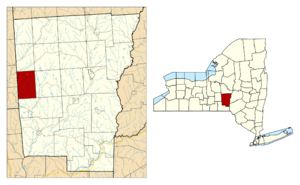German, New York facts for kids
Quick facts for kids
German, New York
|
|
|---|---|
 |
|
| Country | United States |
| State | New York |
| County | Chenango |
| Government | |
| • Type | Town Council |
| Area | |
| • Total | 28.44 sq mi (73.66 km2) |
| • Land | 28.41 sq mi (73.58 km2) |
| • Water | 0.03 sq mi (0.08 km2) |
| Elevation | 1,506 ft (459 m) |
| Population
(2010)
|
|
| • Total | 370 |
| • Estimate
(2016)
|
359 |
| • Density | 12.64/sq mi (4.88/km2) |
| Time zone | UTC-5 (Eastern (EST)) |
| • Summer (DST) | UTC-4 (EDT) |
| FIPS code | 36-017-28739 |
| GNIS feature ID | 0978996 |
German is a small town located in Chenango County, New York, United States. In 2010, about 370 people lived there. The town is named after Obadiah German, who was a U.S. Senator and the original owner of the land. German is on the western edge of Chenango County, west of the city of Norwich.
Contents
History of German
The first people to settle in the area arrived around 1796. The town of German was officially created in 1806. It was first called the "Town of Brakel." It was formed from a part of the town of DeRuyter, which is now in Madison County.
Over the years, the size of German became smaller. This happened as new towns were created from its land. These new towns included Otselic in 1817, Lincklaen in 1823, and a part of Pitcher in 1827. In 1865, the population of German was 778 people.
Geography of German
The town of German covers a total area of about 73.7 square kilometers (about 28.4 square miles). Most of this area is land, with only a very small part being water.
The western border of the town is also the border of Cortland County.
Population Changes in German
| Historical population | |||
|---|---|---|---|
| Census | Pop. | %± | |
| 1820 | 2,675 | — | |
| 1830 | 884 | −67.0% | |
| 1840 | 965 | 9.2% | |
| 1850 | 903 | −6.4% | |
| 1860 | 781 | −13.5% | |
| 1870 | 712 | −8.8% | |
| 1880 | 664 | −6.7% | |
| 1890 | 542 | −18.4% | |
| 1900 | 423 | −22.0% | |
| 1910 | 371 | −12.3% | |
| 1920 | 365 | −1.6% | |
| 1930 | 303 | −17.0% | |
| 1940 | 234 | −22.8% | |
| 1950 | 245 | 4.7% | |
| 1960 | 253 | 3.3% | |
| 1970 | 188 | −25.7% | |
| 1980 | 250 | 33.0% | |
| 1990 | 311 | 24.4% | |
| 2000 | 378 | 21.5% | |
| 2010 | 370 | −2.1% | |
| 2016 (est.) | 359 | −3.0% | |
| U.S. Decennial Census | |||
In the year 2000, there were 378 people living in German. These people lived in 135 households, and 93 of these were families. The population density was about 13.3 people per square mile.
About 39.3% of the households had children under 18 years old living with them. Most households (57.8%) were married couples living together. The average household had 2.80 people, and the average family had 3.32 people.
The population was spread out by age:
- 32.3% were under 18 years old.
- 5.8% were between 18 and 24.
- 29.9% were between 25 and 44.
- 23.5% were between 45 and 64.
- 8.5% were 65 years or older.
The average age of people in the town was 34 years.
Places in German
- East German – This used to be a community in the southeastern part of the town.
- German ("German Four Corners") – This is a small village or hamlet. It's located near the western town line where County Roads 2 and 5 meet.
- German Five Corners – This is another spot north of the German village on County Road 2.
See also
 In Spanish: German (Nueva York) para niños
In Spanish: German (Nueva York) para niños


